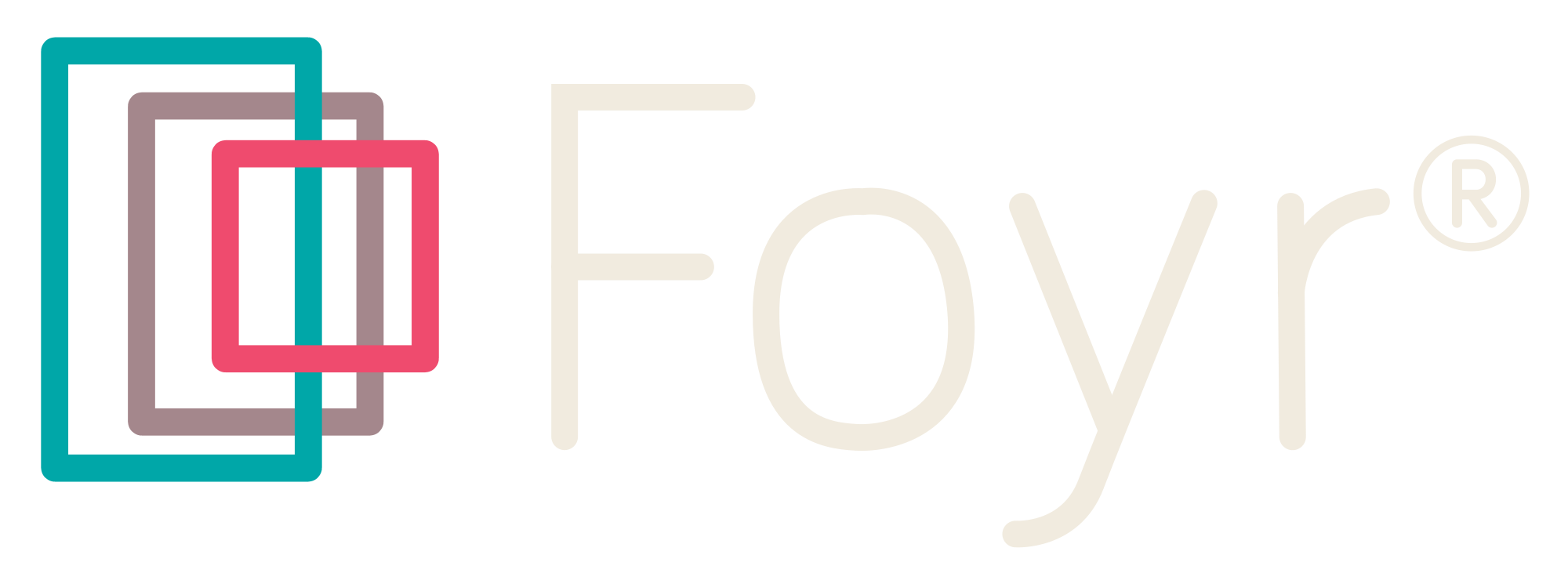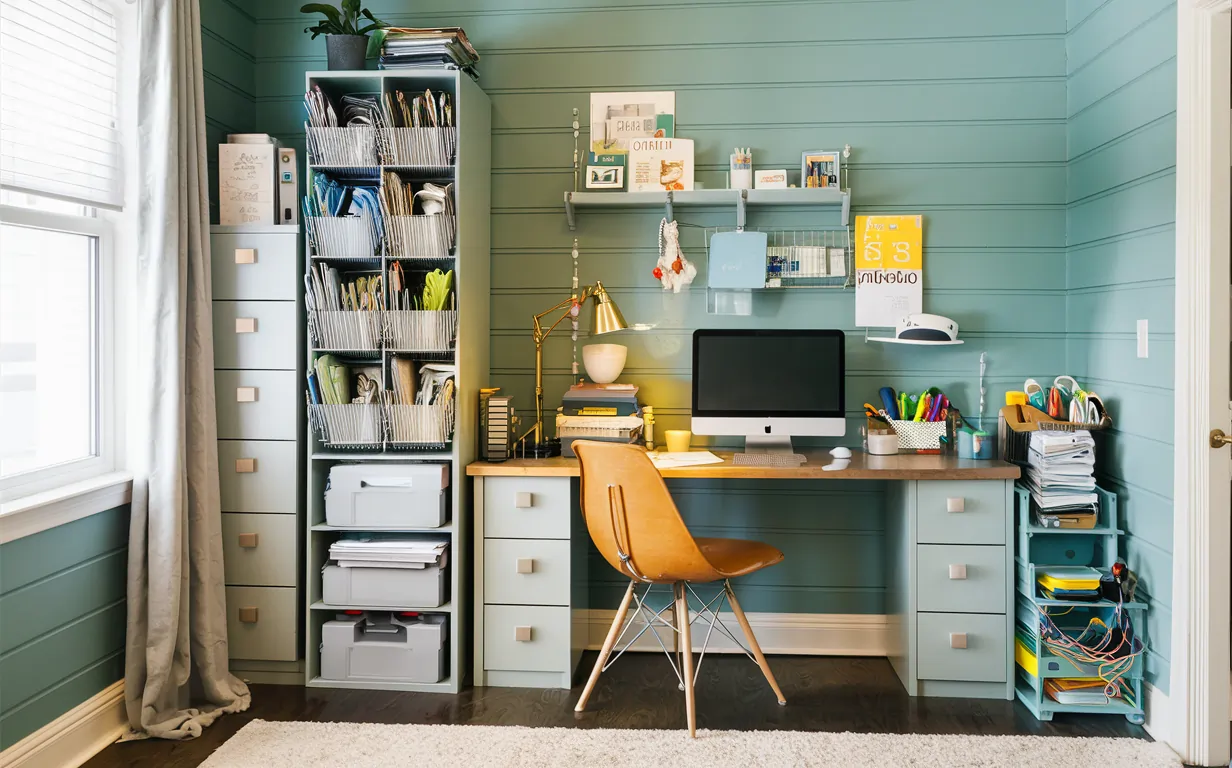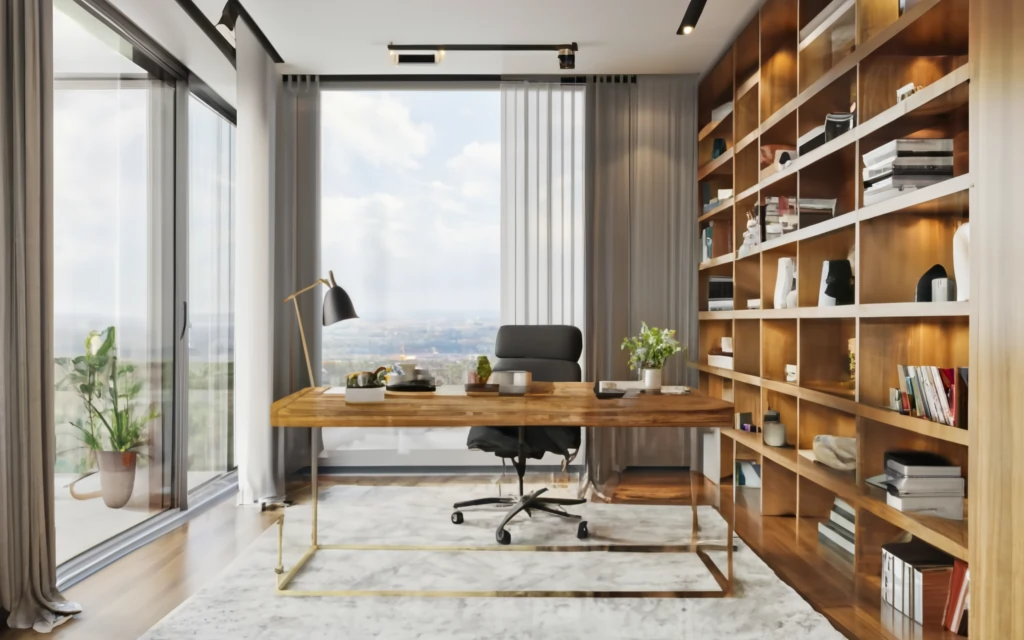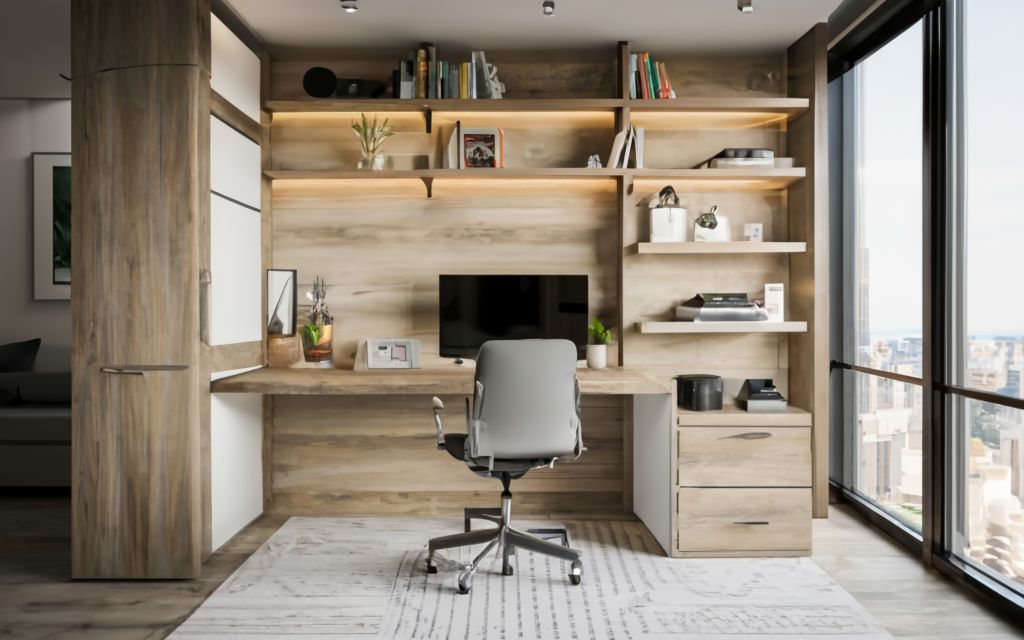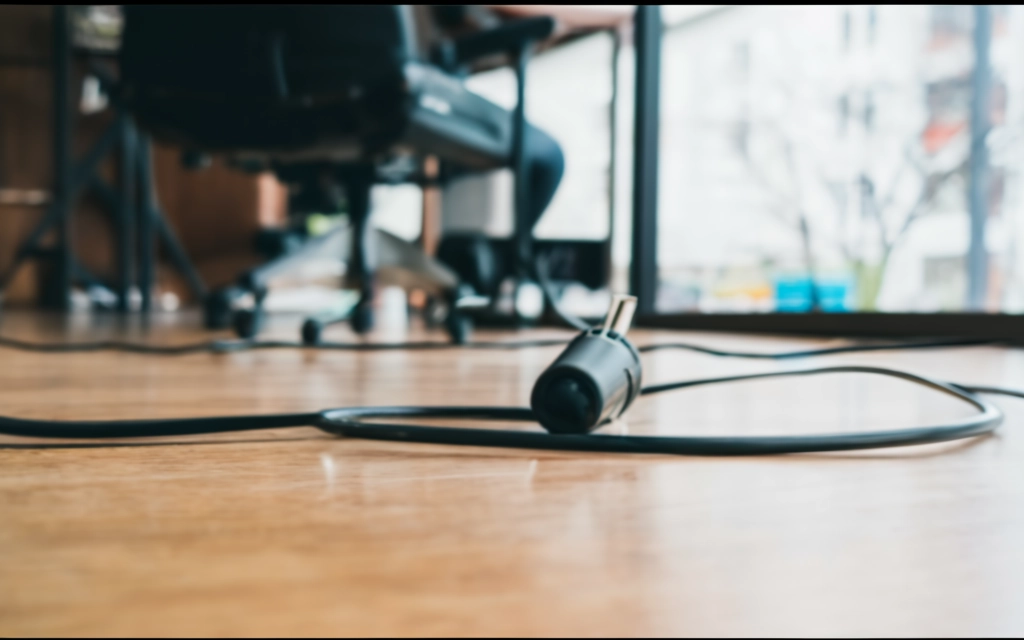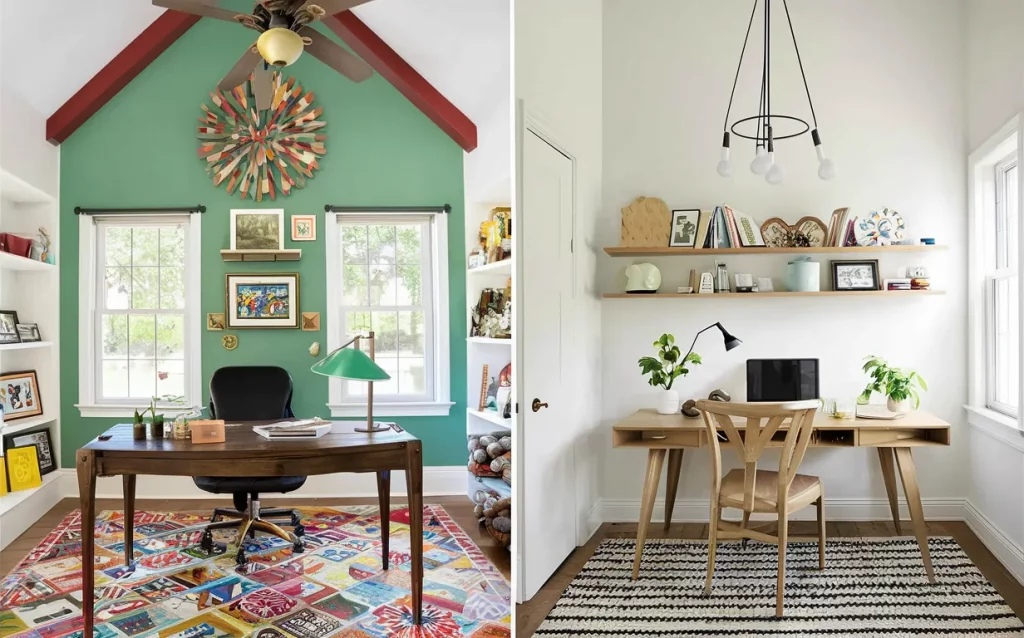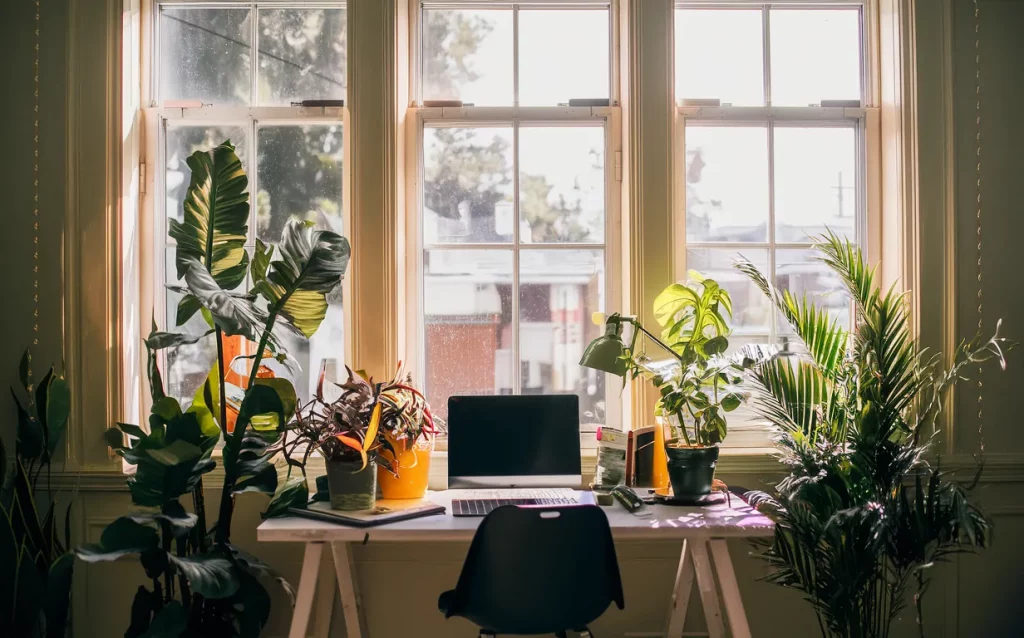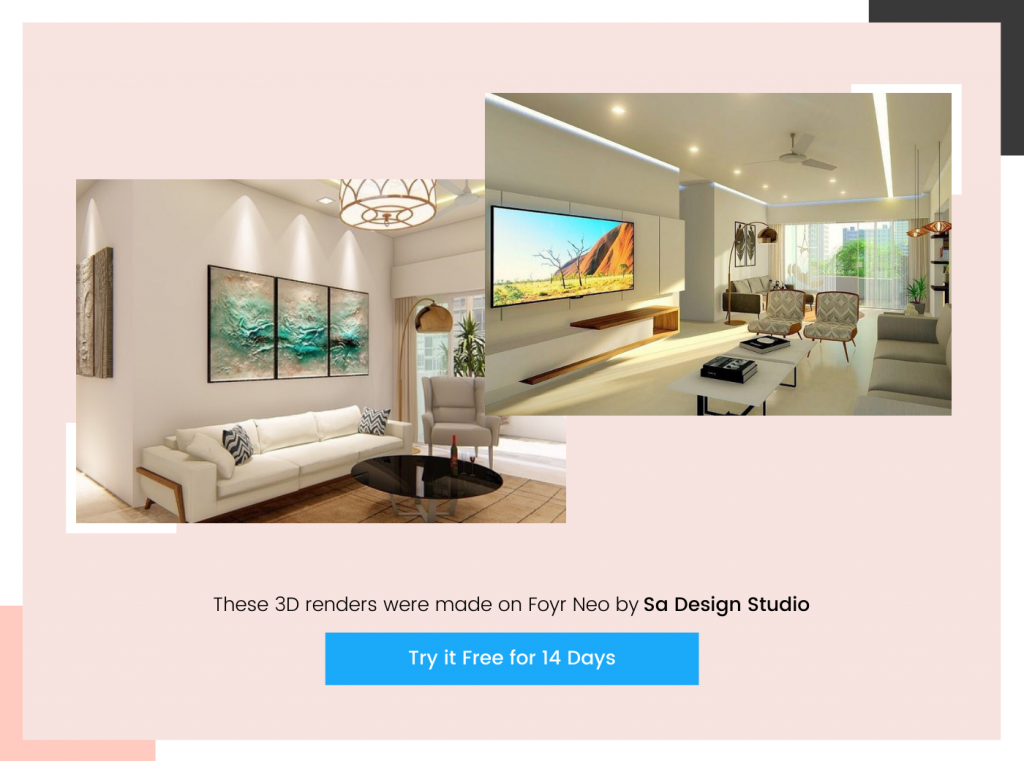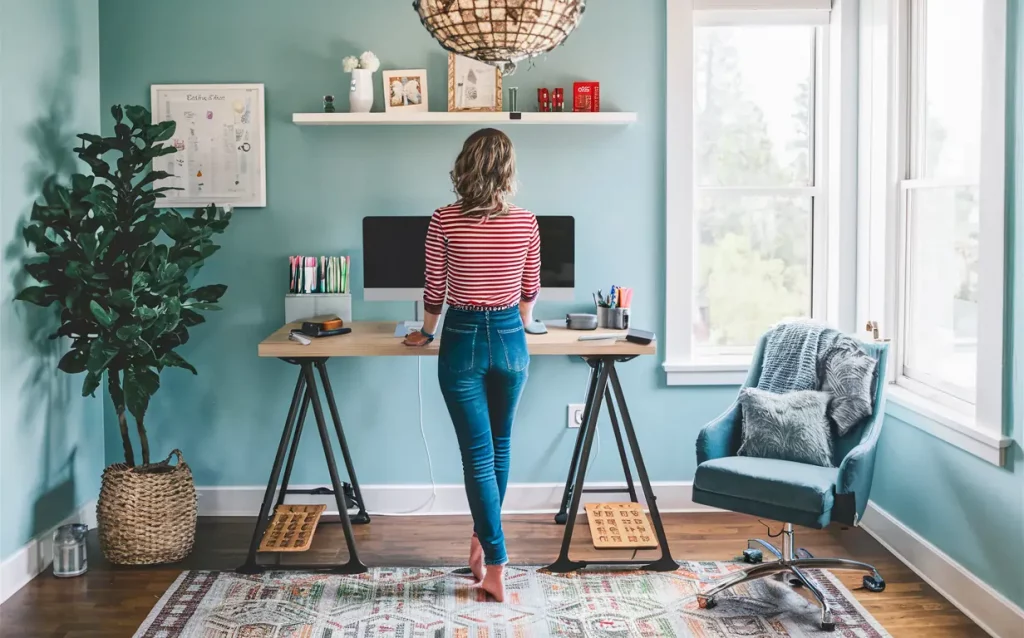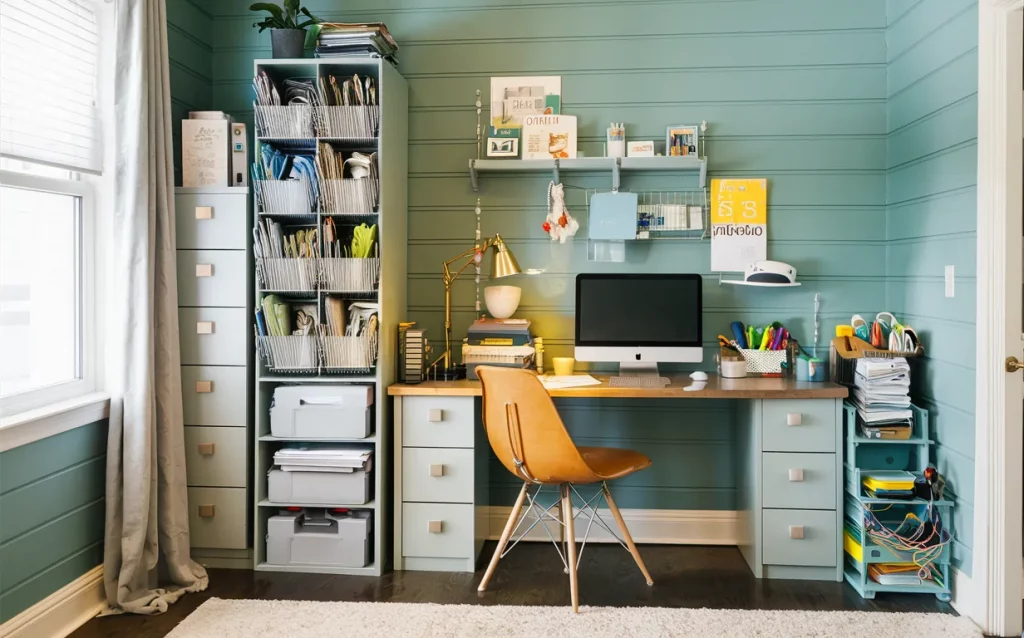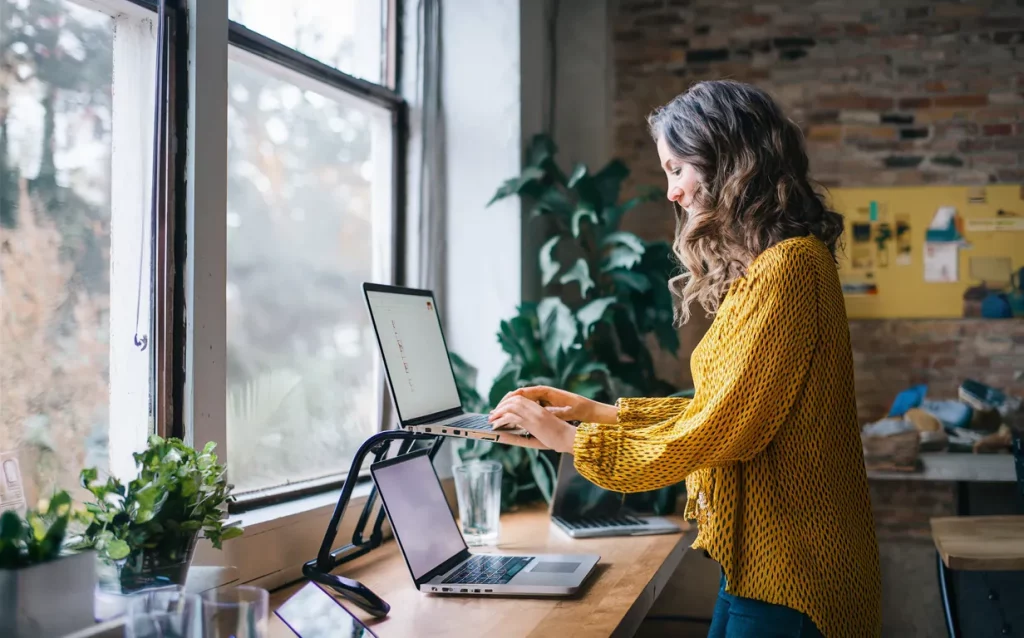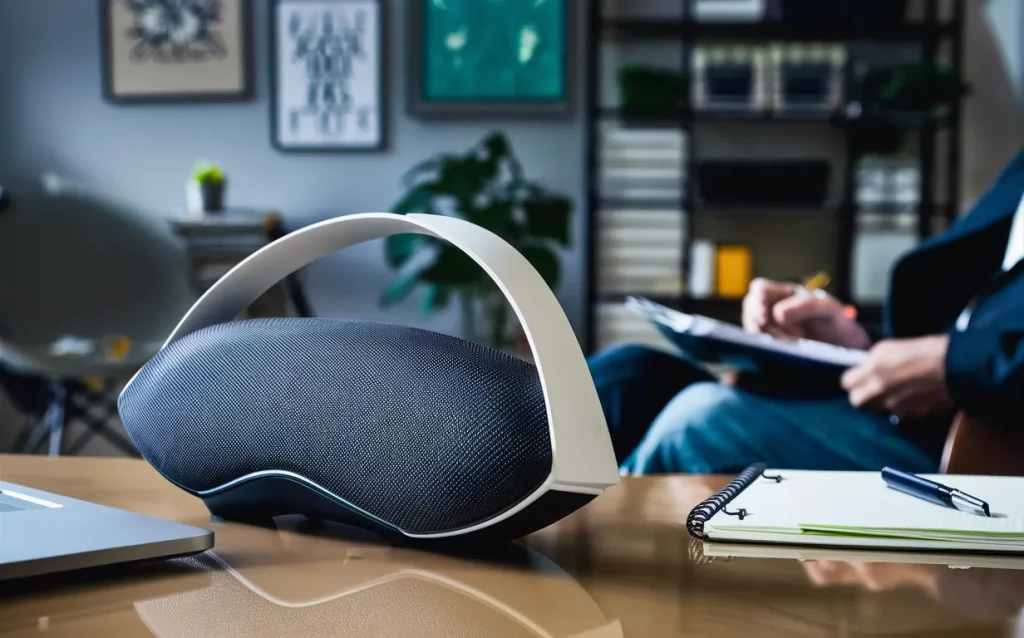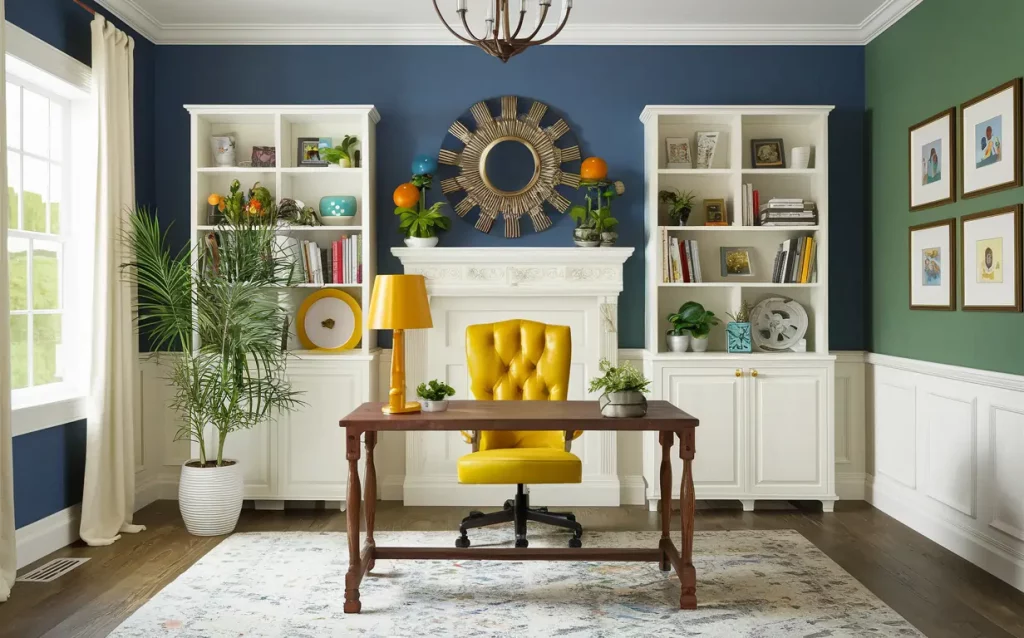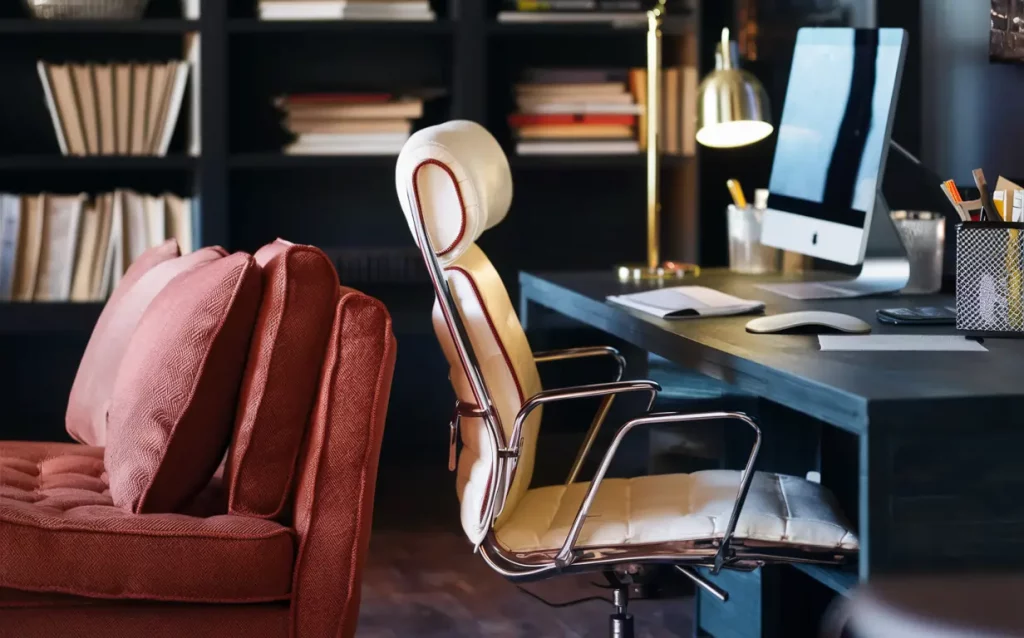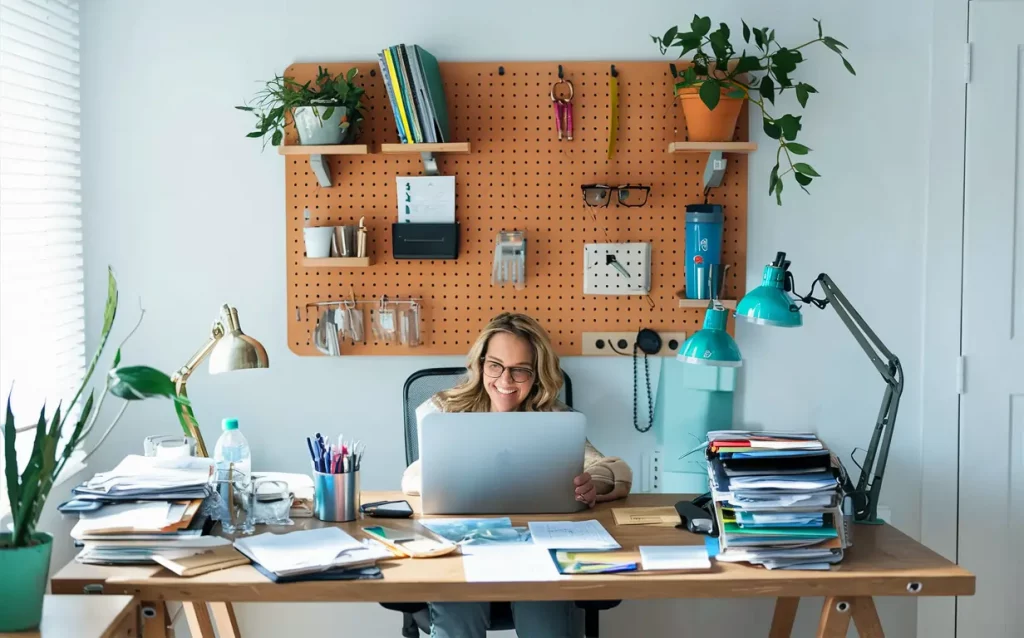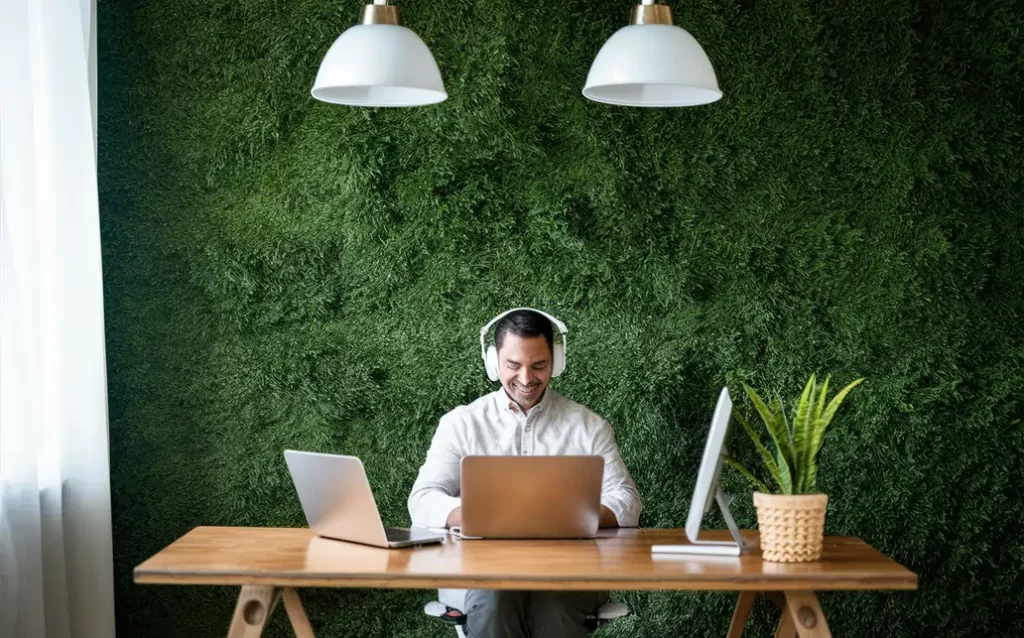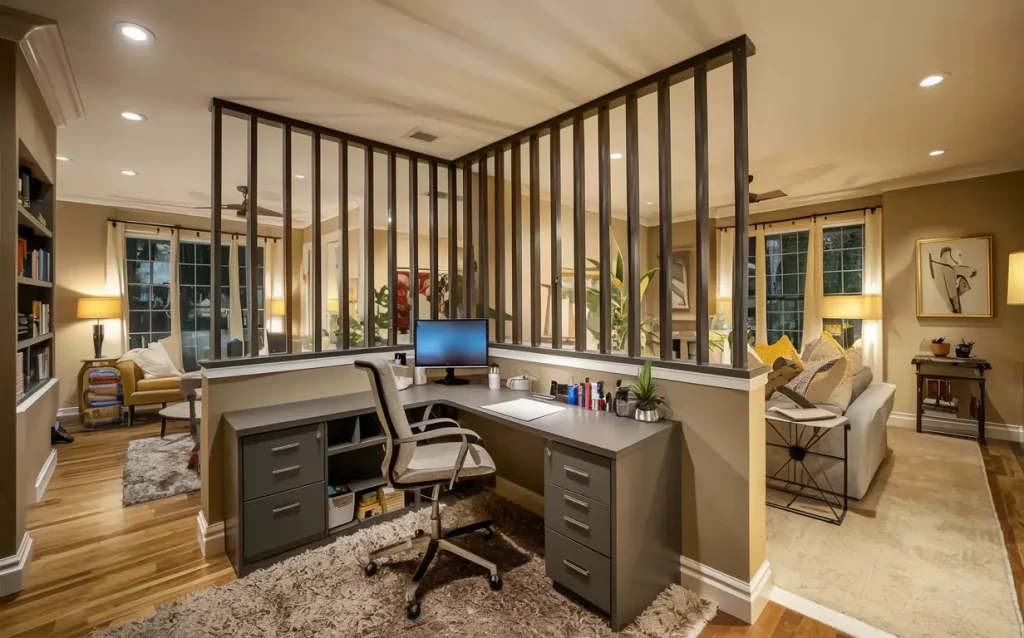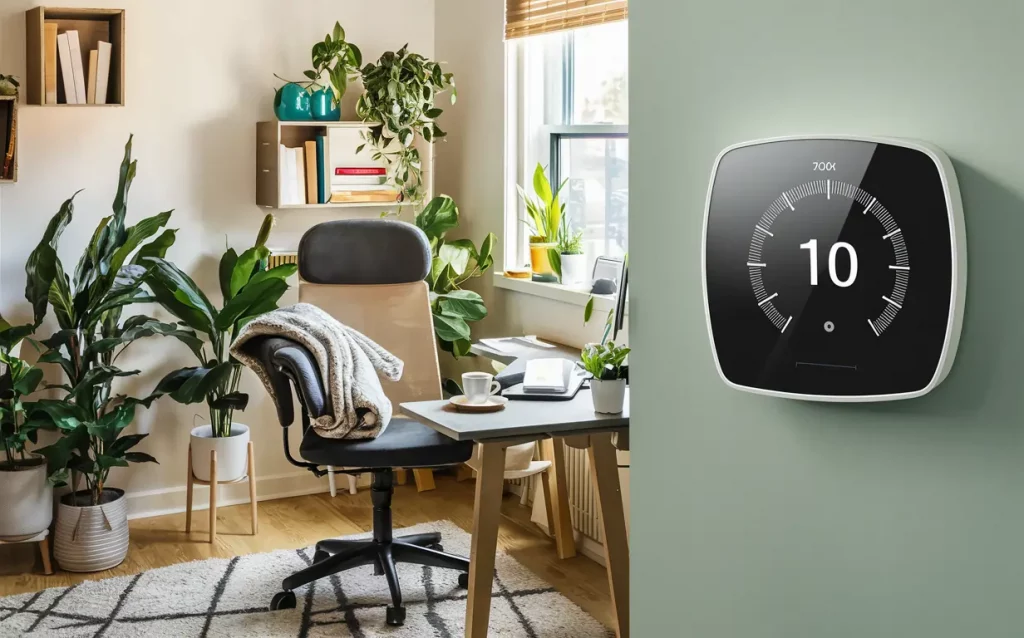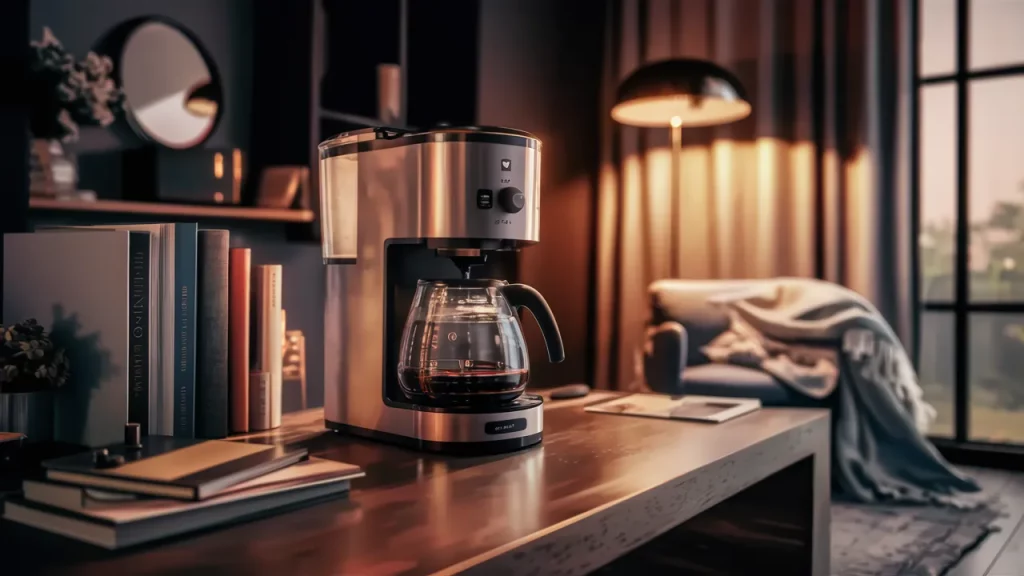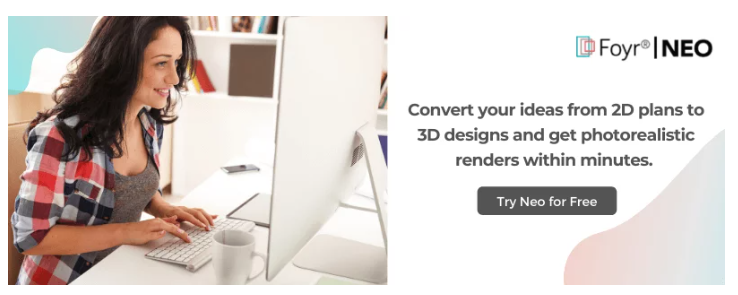Table of Contents
Learn » Design Ideas & Inspirations »
The way we work has changed for good.
COVID-19 may have been the initial reason employees started working from home, but many won’t be coming back to the office five days per week. According to USA TODAY’s report on ‘The DNA of work has changed’, 40% of Americans prefer to work from home full-time, and 35% prefer a hybrid model.
That means they need a workspace at home.
The rise in remote work presents an excellent opportunity for both professional interior designers and homeowners: designing the perfect modern home office. Using home design software, you can easily plan, visualize, and customize your workspace to ensure it’s both functional and inspiring.
Setting your laptop on the kitchen counter just doesn’t cut it anymore. People need comfortable, professional, and attractive workspaces in their homes, and they’re willing to pay for them.
This blog presents the top tips for how to style a modern home office that’s both stunning and functional.
Get These 5 Basics Right Before You Start Designing Your Home Office
1. Prioritize Practicality
You’re excited about the new look you’re going to give the room — we get it. But don’t forget that a home office is a workspace first and foremost. You have to prioritize practicality.
That doesn’t mean your design has to be boring.
It just means that the foundation of your design should be functional. When you’re designing your home office, start with the requirements of a modern workspace and get creative from there.
✅Let’s look at one thing that absolutely every home office needs: a desk.
✅ You should place the desk as close to a natural light source as possible. If the space doesn’t get good light from a window, think about where you’ll place a floor lamp or desk lamp.
✅ Some people love to look out a window when they sit at their desks.
If placing a desk in front of the window is an option, consider your own preferences. If you’re a professional, ask your client how they feel facing a window all day.
✅ Make sure there’s enough space around the home office desk to allow the user to move and stretch.
Read also – Top Interior Designing Software Tools to Learn in 2024
2. Design For a Small Space
Home offices are often created in small rooms or even repurposed areas like an attic. When this is the case, your design should make the most out of the small space.
✅ Less is more. Don’t overwhelm the space with a lot of small items — it may seem counterintuitive, but a few larger pieces will fit a tiny space better.
✅ Floor space is precious in a small home office. A floating shelf unit or folding desk makes use of vertical real estate instead.
3. Plan Where Electrical Cords Will Go
Electrical cords running across the room are ugly. Before you start designing your home office space, make a list of all the tech you need. Consider the location of outlets and where the cords will have to run to reach the computer, monitor, or printer.
✅The most common way to avoid cords laying around is to run them behind furniture. Some designers even paint them to match the wall.
✅A concealed location for printers or other work devices gets them out of the way so your design can take center stage.
Read also – How Can You Mitigate Electrical Hazards as an Interior Designer?
4. Choose What Ambiance You Want to Create
Of course it’s a home office, but depending on the type of work you do, you can design your home office to help you focus better.
✅ If you are into number-crunching, logical, detail-oriented work, opt for lower ceilings. They help converge your thoughts and focus deeply.
✅ However, if you’re into creative work where you deal with abstract concepts, go for higher ceilings.
Similarly, decide what mood you want to set and put together the design.
5. Go Natural
If possible, try to ensure natural light in your workspace.
✅ Sunlight works wonders for productivity and also helps in aiding better concentration.
✅ In addition, add houseplants or desk plants to your workspace for a better aesthetic.
Read also – 15 Easy and Healthy Houseplants To Grow Inside Your Home
13 Pretty and Practical Home Office Design Ideas
1. Height-Adjustable Work Table
A work table is an essential furniture piece for a home office. A height-adjustable table or a standing desk gives you that ergonomic edge and allows you to sit or stand throughout the day, giving your back and body a much-needed stretch.
Depending on the kind of work you have—whether you have a lot of papers to go through, documents to mark up, or stationery requirements, get a large or a smaller table that can easily fit into your designated space without taking up too much room.
Studies suggest sitting for long periods of time can cause serious health issues and weaken the overall strength and endurance of people who lead sedentary lifestyles.
Working at a standing desk means that you are keeping your back and overall posture at the best levels and actually burning calories while simply standing and working. Experts recommend using a standing desk for at least 3 – 4 hours a day.
Read also – 15 Best Ways To Create an Open Floor Plan Layout in 2024
2. Get a Multi Purpose Charging System
If you’re sitting at your desk all day, you need to keep your devices charged. To make things easy, get an all-device charger—a device with all types of jacks—for your phone, laptop, printer, or any other device you may need to use during a workday.
The charging system helps you keep all your gadgets charged all day, and you won’t need to get up from your desk to locate plug points. This also ensures you don’t tangle different chargers and cables together, and end up looking dazed.
Read also – Key Floor Plan Symbols & Architectural Abbreviations to Read Floor Plans Effectively
3. Get a Standalone or Fixed Filing Cabinet
Working from home and need space to store all your documents and files? Have children or pets running around and need to protect your physical files?
A good vertical filing cabinet can solve your problems. Get yourself a cabinet that can blend into the background, isn’t too bulky, and at the same time has enough storage space to keep your files and documents safe.
Everything you need should be well within your reach but never creating clutter. It might take you some time to get used to supplies being in a different place, but hey, you did that at work and it worked just fine!
You should also have dedicated storage for other office supplies you may have. If you want to go the extra mile, you should also invest in storage solutions that help organize your wires for the computer.
| Artem Kropovinsky, founder and principal designer at Arsight says, “For modern design, “less is more”. We strive for understatement by selecting only those pieces that have simple straight lines and minimalist impact on the environment.” |
4. Bring in Multi Layered Lighting
Love burning the midnight oil? Tend to work late into the evening and night? In that case, a good desk lamp is something you need. A desk lamp helps you keep your eyes from feeling strained in low light and allows for better concentration and focus.
Get some string lights/fairy lights to create a relaxing vibe after a long day. Ensure to have ambient, accent and task lighting, so your eyes don’t strain. Moreover, if you’re working a night shift, or take up heavy work towards the evening, you may want to keep yourself fresh by keeping your surroundings well lit.
Naturally, it’s important to be able to see clearly in an office, but the purpose of perfect lighting goes beyond that. Research shows that light affects cognitive performance, mood, and alertness.
For example, people are more alert in bright light. While you might choose lower light levels in a space made for relaxing, like a living room, you want to be wide awake in a home office.
Lighting can also affect your outlook. People have a less positive attitude when exposed to low, cool colored light. Think about how the office will look at all hours.
| Artem Kropovinsky, founder and interior designer at Arsight says, “Lighting is the backbone of interior decoration. Through a careful process of blending natural and artificial lighting, we create just the right ambience while enhancing important features.” |
5. Elevate Your Work Station
Anyone that uses a laptop all day long knows that they need to tilt it in a particular direction or keep it elevated at a height for better ergonomics and ease of typing. Are you someone who uses two or more laptops for your work? This is another reason to get yourself a good laptop stand.
| Dr. Andrew Huberman, a renowned neurobiologist at the University of Stanford says, “Looking up at the elevated workstation and working for an extended period above eye level heightens your state of attention, boosts mental clarity, and eases the stress on the eyes.” |
6. Invest in a High Quality Sound System
Love listening to music while you work? Make sure your home office space has a good Bluetooth speaker. A Bluetooth speaker will help you plug in and play music easily and switch it off with equal ease when you don’t need it. Many people even use them to take conference calls so that the voice is clear and they can easily concentrate on typing or taking notes.
If you’re someone who attends back-to-back meetings all day, using earphones or headphones can hurt your ears after a point. It can be downright painful. According to a study from the National Library of Medicine, prolonged usage of audio devices means you’re highly likely to lose your hearing power soon. Don’t risk it, get a good quality speaker.
Read also – All You Need to Know About Building a Smart Home
7. Flame Productivity with Color
Offices are often bland, with white walls and furniture in neutral colors.
Yours doesn’t have to be!
Understanding the psychology of colors in interior design is pivotal in crafting the perfect home office ambiance. Explore how each hue influences your workspace in the table below:
| Color | Significance in home office design |
| Red | Red can still be a good choice for a working area. It represents ambition, drive, and energy |
| Blue | You feel calm and relaxed in a blue room |
| Green | You feel calm, peaceful, and refreshed |
| Yellow | Associated with happiness, excitement, and intelligence |
| Neutral colors | A classic choice that you probably won’t get sick of when trends change. If you want a hint of color without the distraction, you could choose to do some subtle accents |
| Bold colors | Bright, warm colors make us feel energized and lively, but they can also take away from our focus |
Feel free to spice up your home office design with a blast of color — just remember that color can affect the mindset of the user.
| Artem Kropovinsky, founder and principal designer at Arsight says, “Personalizing spaces is essential. The right color and artwork, for instance, or a little bit of green can turn a plain room into a home as opposed to just another house.” |
8. Prioritize Comfort as Much as Concentration in the Home Office
Get a soft sofa for your home office, to go along with other furniture in your home office. If your back hurts, or you need a power nap, you don’t have to go to your bedroom and take the risk of oversleeping. You can curl up in the comfort of your sofa in your home office.
Getting onto comfortable furniture can also flame your creativity, so consider bringing in, or getting a brand new sofa.
Read also – 10 Furniture Styles & Trends That You Can’t Afford to Miss in 2024
9. A Desk Organizer Saves You Time and Effort
If your desk has many things on it—papers, office supplies, router, water bottle, etc., you need a desk organizer. A desk organizer helps you keep your home office space uncluttered and gives you the freedom to focus better on your work.
Get yourself an all-in-one desk organizer with the capacity to store all your office supplies, work essentials, and items that otherwise lie loosely, creating clutter on your desk.
If you don’t want to keep any stuff on your work table, hang a ped board above your work table, but within reach, so you can reach for your office supplies, or stationery as and when you need them. A peg board can do so much for you – you can hang potted plants, keys, computer glasses, stack notebooks and whatnot.
10. Soundproof Your Home Office
If you’re the type of person that gets easily distracted by noise, you should invest in some soundproofing material that you can apply on your walls.
You should invest in items that will help control the noise level that you hear from the outside world. If you can’t invest in soundproofing material for your home office design, you can buy yourself some noise-canceling headphones.
The less noise you hear, the more productive you will be, and the less stressed you will be when doing your job. Not to mention, it will avoid disturbances during those long conference calls!
Read also – How To Design Meditation And Yoga Spaces At Home
11. Use Dividers to Create a Mini Home Office Space
If you can’t spare a separate home office in your home design, no worries!
Convert a part of your living room, or bedroom into your work haven with room dividers (opaque, translucent, or transparent). You can choose to have an acoustic layering, use them for different purposes (additional storage, to hang pictures, etc).
| Artem Kropovinsky, founder and principal designer at Arsight says, “Think of a personalized bookshelf that acts as both dividing wall. To begin with, it serves as a natural dividing line in addition to providing adequate storage and display area. The design can range from very contemporary to rustic, depending on the look of the room.” |
12. Install Heating and Cooling Systems at the Right Places
In an actual office, you probably don’t have full control over the A/C. Luckily, this won’t be the case for you in your home office.
When you’re setting the temperature on your thermostat, make sure that it is within a comfortable range. You don’t want you to be too hot nor too cold because either one can disrupt you from your work.
Read also – 8 Best Free Interior Design Software & Tools in 2024
13. Get Instant Energy Boosts – Keep a Coffeemaker Handy
Need to give yourself a little energy to function throughout a workday? Get yourself a coffee maker! Whether it’s a French press, hot water kettle, or espresso machine, a coffee maker elevates your overall home office space multifold.
Instead of getting up from your desk to go to your kitchen to pour yourself a cup of joe every time, put one right next to you. A good cup of coffee has great power, especially when you’re working long hours!
Design Your Home Office in Foyr Neo
You have a head full of ideas, a mood board to use as a benchmark, and a list of essential elements. It’s time to put it all together. There are a lot of ways you could do that, but by far the most effective (and fun) is with interior design software like Foyr Neo.
Here’s why:
✅ You can get the plan right
You can draw the exact dimensions of your room, including doors and windows, or upload a floor plan to the software. This ensures you have an accurate understanding of how your furniture and decor will fit.
✅ You can use pre-built 3D models
Ready to arrange furniture in your room? Just drag and drop pre-modeled products into place or upload your own. This makes it easy to play with ideas and experiment with different types of office furniture.
For example, Foyr Neo comes with 60,000+ 3D models and textures you can add to your design, including the entire home office setup shown below.
✅ You can render your design realistically
3D rendering essentially means taking a snapshot of your design — a beautiful one that looks almost like a photograph.
Once you’ve used the interior design software to place all of your furniture and other design elements, choose an angle and lighting for your render. Show your clients (or your friends!) exactly what your home office will look like. Sign up for 14-day free trial today!
FAQs
Use room dividers, area rugs, or furniture arrangement to visually separate the home office area from the rest of the room.
Utilize dual-purpose furniture, compact storage solutions, and scheduling systems to optimize shared use of the space.
Consider DIY projects, repurposing existing furniture, and investing in versatile pieces that can adapt to evolving needs over time.
Incorporate features like a designated backdrop area, and sufficient and comfortable seating for guests or clients.
Select a few meaningful items like family photos, motivational quotes, or favorite mementos to personalize the space tastefully.






